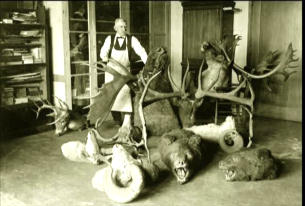

 The Accurate Reloading Forums
The Accurate Reloading Forums  THE ACCURATE RELOADING.COM FORUMS
THE ACCURATE RELOADING.COM FORUMS  Hunting
Hunting  Taxidermy
Taxidermy  Elephant tusks
Elephant tusksGo  | New  | Find  | Notify  | Tools  | Reply  |  |
| One of Us |
I’m finally picking up two sets of long waited elephant tusks! Party Time! It only took 8 months…. It sure felt like a life time. I would like to mount the tusk onto a credenza that I’m going to build and I believe the best way is to fill the nerve canal with a hardener of some sort and install two all-thread bolts into the hardener. What type of hardener do I use? NRA Member SCI Member & DSC Member Double Rifle Shooter's Society So. Cal. Chapter | ||
|
| one of us |
I'm not a taxidermist and I'm not sure I understand what you mean but you need to remember that ivory expands and contracts and if you fix a solid object into the tusk, it might cause cracking. | |||
|
one of us |
I basically had the same idea with my set of tusks. But lots of inquiries and reading ended with me getting worried about the epoxy expanding and breaking the tusks or other potential damage so I finally chickened out and just made metal caps for them. | |||
|
| One of Us |
My solution: I shaved a fir 4X4 down to fit into the nerve canal. I then filled the void with some expansion foam and capped it off with epoxy. I hadn't even thought about the differential expansion factor, I did it this way to give me something to screw large lag bolts into. Balancing the tusks, I was able to drill pilot holes into the wood and the tusks sit well balanced and solid. No bending of threaded rod. | |||
|
| One of Us |
First of all if you keep the tusks in a climate controlled area they should neither expand nor contract. Take the tusks and stand them up on end. Balance them as best you can holding lightly with the tip of your fingers. Then have someone else using a spacer and a marker, scribe a line all the way around the base circumference. Next using a hacksaw blade very carefully and slowly cut down the scribed line and remove the small angular portion of base. Your tusk should be able to stand freely and verticaly, on its own, if set on a level surface now. Now get a piece of 3/4 inch or larger all thread. Bend it carefully so it follows the curve of the nerve but when it exits the base it is located in the center of the base and is perpendicular to the base cut. Cut a small piece of plywood that is larger than the nerve hole. Now using a nut and washer on each side secure the piece of ply wood to the allthread that is exposed out the bottom of the tusk base. The plywood should be flush with your base cut you made earlier and the allthread should still be perpindicular to this cut. Next mix a small amount of high density urethan foam and poar into the nerve. Do not use too much you only want the foam to fill the nerve cavity and stop about 2 inches from the top. Poar into the cavity and then place the allthread with the attached plywood back into place and using manual pressure hold the exposed rod in place and the plywood flush with the base for 20 minutes. Next let it sit and cure for at least one hour then remove the plywood piece. Your allthread should now stay in place. Next, using a knife cut a few divets into the foam. Mix about 16 ounces of bondo with about 2 ounces of fiberglass resin. Fill the remaining 1-2 inches of nerve hole with this mixture and let harden. Let everything sit one day to cure and then drill a hole in your stand and place tusk on the stand. Secure with a washer and bolt from below. Congrats and good luck with your beatiful trophy. | |||
|
| Powered by Social Strata |
| Please Wait. Your request is being processed... |
|

Visit our on-line store for AR Memorabilia

